Cell division
Chromosomes carry genetic information in a molecule called DNA. A type of cell division called mitosis ensures that when a cell divides each new cell produced has the same genetic information.
Chromosomes and DNA
Chromosomes carry genetic information in a molecule called DNA.
A type of cell division called mitosis ensures that when a cell divides each new cell produced has the same genetic information.
DNA exists in a cell's nucleus within structures called chromosomes. Each section of a chromosome that contains the code for the production of a particular protein is called a gene.
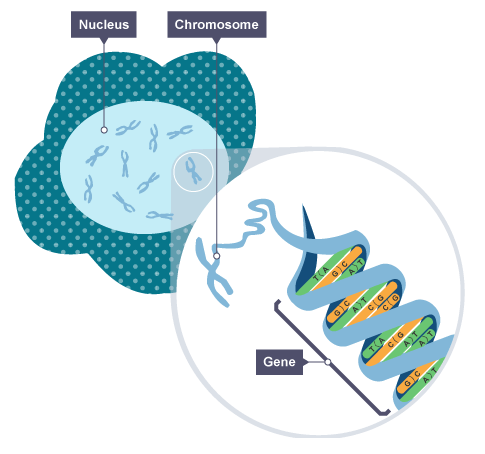 Each chromosome is made from a single molecule of DNA, but when a cell is ready to divide, the DNA copies itself, then coils and condenses to form the chromosomes that we see in micrographs.
Each chromosome is made from a single molecule of DNA, but when a cell is ready to divide, the DNA copies itself, then coils and condenses to form the chromosomes that we see in micrographs.
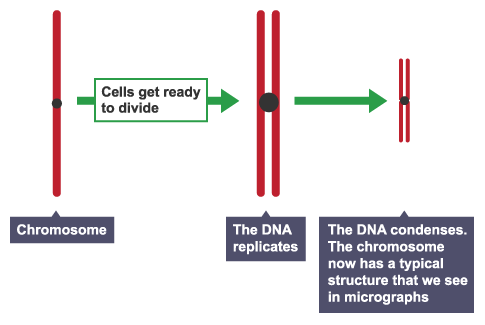
Each human body cell contains 46 chromosomes. These can be arranged into 23 pairs.
Each chromosome in a pair carries the same types of genes. The 23rd pair are the sex chromosomes:
- In females, the two chromosomes are identical in shape. There are two X chromosomes. Females are referred to as XX.
- In males, one of the chromosomes is a different in shape. There is an X and also a Y chromosome. Males are referred to as XY
Mitosis and the cell cycle
Mitosis
Cells divide when:
- an organism grows
- an organism becomes damaged and needs to produce new cells
It is essential that any new cells produced contain genetic information that is identical to the parent cell.
The cell cycle
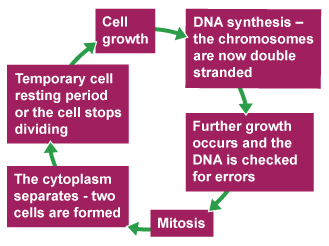
A growing and dividing cell goes through a series of stages called the cell cycle.
The first stages of the cell cycle involve cell growth, then synthesis of DNA. The single strand of DNA that makes up each chromosome produces an exact copy of itself.
The cell undergoes a type of cell division called mitosis.
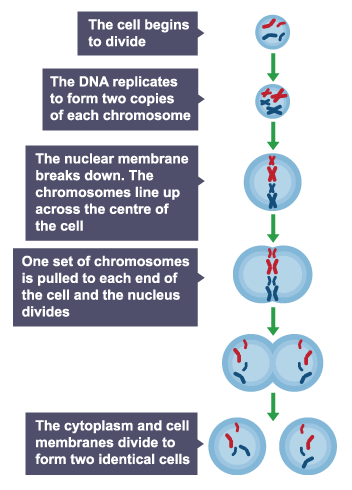
In mitosis, two cells called daughter cells are produced, each identical to the parent cell.
When looking at cells with a microscope, the length of different stages of the cell cycle can be estimated using the formula:
Length of time in phase =

Stem cells
Stem cells in humans
Stem cells are cells that have not undergone differentiation. A cell which has not yet become specialised is called undifferentiated.
An embryo develops from a fertilised egg. Cells at the early stages in the development of the embryo are stem cells.
If cells are removed from the embryo – called embryonic stem cells - they will differentiate into any cell type.
Some stem cells remain in the bodies of adults – adult stem cells. Adult stem cells are found in limited numbers at certain locations in the body.
Adult stem cells can be found in several regions of the body, including the:
- brain
- eyes
- blood
- heart
- liver
- bone marrow
- skin
- muscle
Adult stem cells can differentiate into related cell types only, for example, bone marrow cells can differentiate into blood cells and cells of the immune system but not other cell types.
Stem cells in plants
Cell division in plants occurs in regions called meristems.
Cells of the meristem can differentiate to produce all types of plant cells at any time during the life of the plant.
The main meristems are close to the tip of the shoot, and the tip of the root.
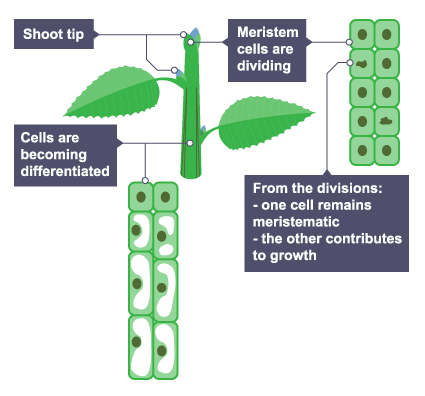
In a growing shoot, new cells are being produced continuously near the tip. As the cells become older, further away from the tip, they become differentiated – they enlarge and develop vacuoles.
Cell differentiation
Animals and plants produced by sexual reproduction begin life as a single cell – a fertilised egg or zygote.
This cell must divide to produce a multicellular organism. It must also differentiate so that its cells develop features that enable them to fulfil specific roles.
Specialised cells in animals
| Cells of the… | Specialised to… |
|---|---|
| Circulatory system | Transport substances, defend the body, regulate temperature |
| Excretory system | Remove waste products and unwanted substances, regulate the water content of the body |
| Muscular system | Bring about movement |
| Nervous system | Respond to internal and external stimuli and conditions, carry messages for the body work as a coordinated whole |
| Respiratory system | Deliver oxygen for respiration and remove waste |
| Reproductive system | Bring about fertilisation to produce new offspring |
| Skeletal system | To bring about movement, support and protect internal structures, produce blood cells, store and release calcium |
Specialised cells in plants
| \n Cells of the… | Specialised to… | |
|---|---|---|
| Leaf | Palisade mesophyll | Carry out photosynthesis |
| Spongy mesophyll | Allow gases to circulate for the exchange of gases between the leaf and the environment, carry out some photosynthesis | |
| Guard cells | Open and close to control the exchange of gases – carbon dioxide, water vapour and oxygen | |
| Phloem | Sieve tubes | Transport products of photosynthesis, including sugars and amino acids, from the leaf to where they are needed |
| Companion cells | Provide the energy required for transporting substances in sieve tubes | |
| Xylem | Xylem vessels | Transport water and dissolved minerals from the roots, up the plant |
| Growing points | Meristem | Produce new cells as they divide |
Cloning in plants
Cells from meristems can be cloned. Meristematic cells are removed from a plant and grown in tissue culture. The cells are grown in a culture medium that contains agar – to provide support and water for the growing cells – along with nutrients and plant hormones to stimulate growth and cell division.
Plants are cloned to produce identical plants quickly and economically.
Producing new plants by cloning is quicker than allowing plants to reproduce and collecting and sowing seeds. It’s therefore an effective way of producing new individuals from rare and endangered plants, helping to preserve the species.
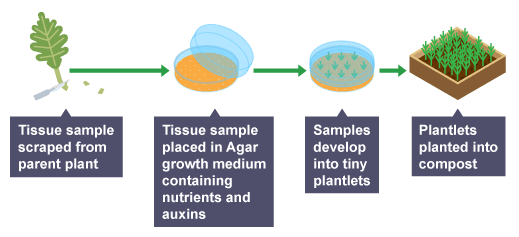
Clones will be genetically identical to the original plant providing the meristem cells. This is useful to provide crop plants for large-scale cultivation that have desirable characteristics such as disease resistance.
Tissue culture and cloning are important in growing identical plants produced by genetic engineering.
Cloning in plants also occurs naturally, for instance, in runners in strawberry plants. An older, simpler method of cloning plants that gardeners use to produce new, identical plants is by taking cuttings.
Using human stem cells
Stem cells can divide to produce new cells, which can then divide into different cell types. They therefore have the potential to be transplanted into patients to treat medical conditions and disease. They could be used to replace cells that have been damaged or destroyed, eg:
- in type 1 diabetes
- in cases of multiple sclerosis, which can lead to paralysis
- in cases of spinal cord or brain injury, that have led to paralysis
The stem cells used could be:
- embryonic stem cells
- adult stem cells
Embryonic stem cells can differentiate into a wider range of cell types, but are difficult to obtain and their use raises ethical challenges. The best source is the five-day-old embryo.
Adult stem cells will differentiate into a narrower range of cell types. Bone marrow transplants are an example of adult stem cell transplant. Bone marrow cells will differentiate into different types of blood cell. Bone marrow transplants are carried out:
- in cases of blood cell cancer such as leukaemia and lymphoma
- when blood cells have been destroyed by cancer treatment
Therapeutic cloning
Transplanting stem cells
Adult stem cell transplants could use a patient's own stem cells or be from a donor. Those that use the patient’s own stem cells would be genetically identical and would not be rejected by the patient's immune system.
Those from a donor would not be genetically identical. Fewer complications would arise if the stem cells came from a close member of the family. Alternatively, donor cells could come from a person with closely-matched tissue types.
Therapeutic cloning
Therapeutic cloning could produce stem cells with the same genetic make-up as the patient.
The technique involves the transfer of the nucleus from a cell of the patient, to an egg cell whose nucleus has been removed.
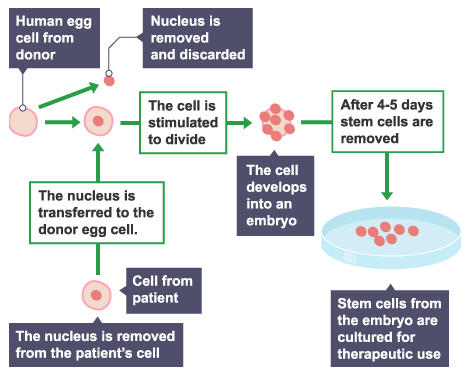
Stem cells produced in this way could be transferred to the patient. Although human stem cells have been produced in this way, and used in research, there is no evidence that, as yet, they have been used to treat anyone.
Benefits and risks associated with the use of stem cells in medicine
Stem cells have great potential, in treating patients with currently untreatable conditions, growing organs for transplants, and research. But there are clinical, ethical and social issues with their use. These issues will be different for growth and transplant of adult, embryonic and therapeutically-cloned stem cells. They will also depend on whether the stem cells are to be used for therapy or research.
It is important to obtain a balanced view. Sometimes, there are no right or wrong answers, or even answers at all.
Some variables which would be considered when discussing stem cells include:
Clinical issues
- There is no guarantee how successful these therapies will be, for example the use of stem cells in replacing nerve cells lost in Parkinson’s disease patients.
- The current difficulty in finding suitable stem cell donors.
- The difficulty in obtaining and storing a patient’s embryonic stem cells. These would have to be collected before birth - some clinics offer to store blood from the umbilical cord when a person is born.
- Mutations have been observed in stem cells cultured for a number of generations, and some mutated stem cells have been observed to behave like cancer cells.
- Cultured stem cells could be contaminated with viruses which would be transferred to a patient.
Ethical issues
- A source of embryonic stem cells is unused embryos produced by in vitro fertilisation (IVF)
- For therapeutic cloning is it right to create embryos for therapy, and destroy them in the process?
- Embryos could come to be viewed as a commodity, and not as an embryo that could develop into a person.
- At what stage of its development should an embryo be regarded as, and treated as a person?
Social issues
- Educating the public about what stem cells can, and can't do, is important.
- Whether the benefits of stem cell use outweigh the objections.
- Much of the research is being carried out by commercial clinics, so reported successes are not subject to peer review. Patients could be exploited by paying for expensive treatments and being given false hope of a cure as stem cell therapies are only in their developmental stages.